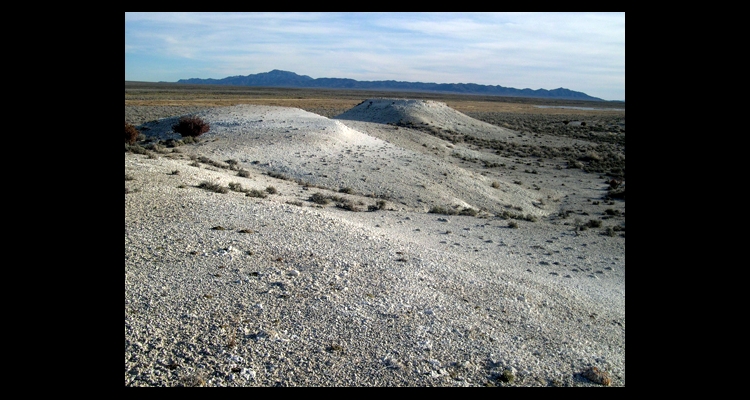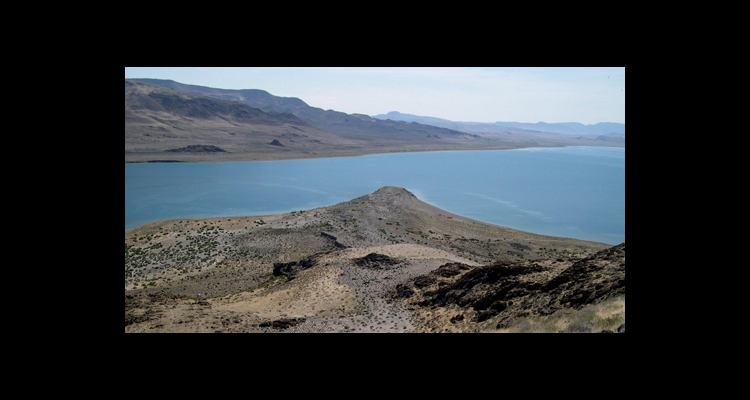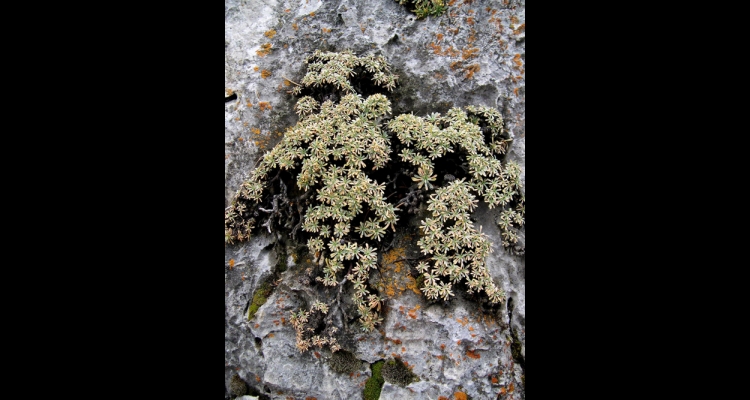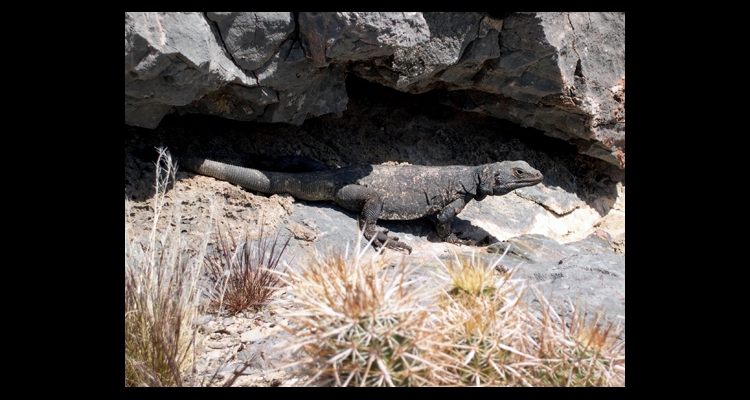Ecological Islands
In the White River Valley of eastern Nevada, chalky white mounds rise gently above the sagebrush and greasewood of the valley floor. These mounds [Figure 1] are made of calcium minerals that precipitated out of the waters of old springs. Today, the spring mounds are the habitat of an unusual set of mostly low-growing plants [Figure 2] that look like they belong in alpine tundra more than among the shrubs of the valley. For these plants, the mounds are like islands surrounded by an ocean of inhospitable habitat.
Although the spring mounds of the White River Valley are peculiar, they represent a widespread and general influence on Nevada's biota: small patches or larger areas of one kind of environment surrounded by different, often more common, environments. The number, character, and history of these ecological islands (or patch ecosystems) are keys to understanding much of the state's biodiversity. Because of their vulnerability to human impacts, ecological islands also highlight threats to that diversity.
Nevada's ecological islands come in many forms. A handful of them, such as Anaho Island in Pyramid Lake [Figure 3], are islands in the normal sense. Many are montane areas, so-called “sky islands,” surrounded by the generally hotter, drier environments of valleys. Elevation-based islands occur within mountain ranges as well; for example, some Nevada ranges have islands of treeless alpine tundra [Figure 4] on their highest peaks. A large number of ecological islands are tied to the underlying rock or soil. The White River Valley spring mounds are islands of this sort, as are other badlands, rock outcrops [Figure 5], and sand dunes [Figure 6]. Caves, common in the eastern part of the state, are also substrate-based islands, because they almost always occur within limestone or similar rocks that are easily dissolved by water. Finally, there are many aquatic islands, including permanent lakes and springs [Figure 7] and temporary playa lakes.
Any sizeable region has ecological islands, but Nevada has an especially large number of them. Why is this? Perhaps the most obvious reason is that the basin and range topography of alternating mountains and valleys means that the region has numerous isolated “sky islands.” In addition, the faulting that created the basin and range landscape allows water to descend deep into the Earth, where it is heated and forced back to the surface in hot springs; Nevada has hundreds of such springs, and many of them are especially unusual environments. Finally, geology and climate combine to explain substrate-based islands. Like most of the western US, Nevada has had an active geological history, marked by numerous collisions of tectonic plates and episodes of volcanism. This varied history has created a complex patchwork of rock and soil types; because the region is so dry, these often are exposed rather than being buried under layers of decaying plant matter. Most substrate-based islands, like the White River Valley spring mounds, are the result of this patchwork of exposed rock and soil types.
Nevada is, for the most part, a cold desert, not an area that immediately comes to mind as a hotspot for biodiversity. However, largely because of its ecological islands, the number of plant and animal species in the state is surprisingly high. The number of species in a region is tied to the diversity of environmental conditions and, in Nevada, environmental diversity is, to a significant extent, tied to the great diversity of ecological islands. The badlands, outcrops, sand dunes, caves, alpine tundra, subalpine woodlands, lakes, springs, and playas are home to hundreds, if not thousands, of plant [Figure 8] and animal [Figure 9] species that otherwise would not exist within the state.
Many Nevada species or subspecies evolved their genetic uniqueness precisely because their ancestors became isolated on ecological islands, just as isolation on islands in the ocean has led to the evolution of new forms. These taxa often are found on only one or a few ecological islands. Almost all of Nevada's very rare plants and animals are such isolated forms with extremely limited distributions. The well-known Devil's Hole pupfish (Cyprinodon diabolis) is the most extreme case: it is found only in a single 70-by-10-foot spring pool, the smallest range of any vertebrate species in the world. Other rare Nevada island species or subspecies include many snails [Figure 10] and fishes in springs, the cui-ui sucker (Chasmistes cujus) of Pyramid Lake, several cave arthropods, a variety of alpine plants, and many insects [Figure 11] and plants restricted to sand dunes.
How did island species end up where they are today? The answers to this question are tied to the history of the islands themselves. Some ecological islands arose already isolated from other environments of the same kind. For instance, the various sand dune areas were created separately by local wind patterns and the availability of sand; they always have been widely separated islands. Other substrate-based islands also arose in isolation. Although some species have colonized such islands from bordering, dissimilar environments, many species reached these islands by traveling long distances from other islands of the same kind.
Not all ecological islands arose in this way, however. Some kinds of islands, particularly those based on elevation or the availability of water, were once part of much larger, contiguous areas of similar environments that since have become fragmented. For example, during parts of the Pleistocene when the climate of the Great Basin was cooler and wetter than it is today, Pyramid Lake and Walker Lake were part of vast Lake Lahontan, which at its largest was more than five times the current area of the Great Salt Lake. As the climate became drier, the water level of Lake Lahontan fell, eventually leaving only the widely separated “islands” of Pyramid and Walker Lakes. Similarly, bristlecone pine (Pinus longaeva) and limber pine (Pinus flexilis) forest was more widespread and contiguous in the Great Basin during the Pleistocene; a warmer, drier climate has driven this forest to higher elevations and in the process has fragmented it into islands of suitable habitat in the high mountains.
A history of fragmentation of formerly connected environments implies that some plants and animals that are found in more than one island never had to move across the unsuitable habitat between islands. Instead, these organisms probably were distributed throughout the larger area and became isolated as that area broke up into islands. In fact, the existence of some of Nevada's isolated species is very difficult to explain in any other way. For instance, many small fishes are found in springs that are completely disconnected from other aquatic environments. The existence of these fishes must be explained by past aquatic connections that disappeared as the climate became drier.
Since the Pleistocene, many of Nevada's ecological islands have vanished through natural causes, such as general regional drying. However, other islands are now being degraded or destroyed at an especially rapid rate by an assortment of human activities. For instance, off-highway vehicle use has despoiled dunes such as Sand Mountain. On a larger scale, extensive use of surface water and groundwater has altered or eliminated many aquatic islands. For example, because of diversions of water for irrigation, the salinity of Walker Lake has increased greatly, threatening fishes and other aquatic life. The impacts of human-caused global climate change may be especially dire for Nevada's ecological islands. The small areas of alpine tundra are a case in point; climate warming may drive all montane life zones upslope, but alpine tundra, with its unique assortment of plants and animals, has nowhere higher to go and may disappear off the tops of many Nevada mountain ranges. Meanwhile, urban islands, filled with pigeons and house mice, undoubtedly will continue to grow.
Article Locations
Related Articles
None at this time.
Further Reading
None at this time.










